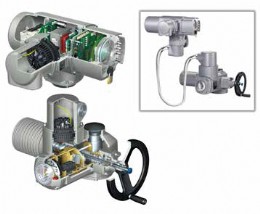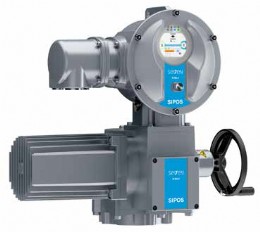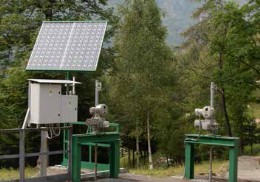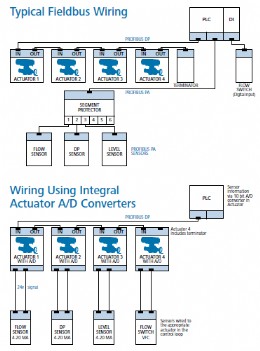Adding Value To The Motor Operated Valve (MOV)
In common with many industries, the valve control market faces increasing pressure from commoditisation of its products.

AUMA’s modular construction, with three axes of assembly, allows 64 different build orientations

AUMA control head unit (upper) and motor gearbox drive unit (lower) with common interface. Inset image shows control and motor drive unit connected by an umbilical cable.

SIPOS SEVEN electric actuator – advanced variable speed control with colour interface

SIPOS Solar remote controlled actuation solution linked to a penstock and level sensor. The integral on-board PID controller saves using an additional PLC.

Using the AUMA actuator’s integral A/D converter can reduce system costs in typical fieldbus applications.
• Control system design and actuator specification
• Plant installation and commissioning
• Plant operation
• Maintenance and asset management
Each stage involves different teams with a diverse range of requirements. The four articles consider how the provision of an integrated control system actuator solution, rather than a simple hardware sale, better satisfies the differing customer needs and adds real customer value. In this first article we will consider the control system design and actuator specification stage of the process. Control system design and actuator specification Mind / muscle interface.
The electric actuator for valve control must span two different disciplines: the ‘intelligence’ of managing analogue or digital control signals & feedback and the creation of ‘brute force’ using linear or rotary motion to open / close different valve types.
These two disciplines are generally considered separately throughout the life of the actuator, whether it be in the initial controls design stage or the skill requirements for plant installers and maintenance teams.
AUMA’s approach was to design a product which reflected the different disciplines by creating the modular actuator solution in which the control head is separate from the motor gearbox drive unit, but uses a common interface to connect the two components.
Using this interface throughout the product range means that different control heads whether mechanical (AM Controls) or digital (AC Controls) can be bolted to different drive units. In addition, to provide greater design flexibility, the control head can be mounted at any one of four different orientations. This is also true of the electrical connector and control interface. In this way the same basic actuator can be built, or modified on site if necessary, to any one of 64 different build orientations. This gives maximum design flexibility and ensures the display is easy to read by the operator. The control engineer can also mount the control head remotely from the drive unit using an umbilical cable up to 100 metres in length. This can be used to provide a safer solution to valve control systems which are used, for example, in underground locations.
Sophisticated control with variable speed actuation
Many applications can be satisfied with simple open / close functionality, however more demanding applications require a higher level of valve control. Water hammer poses a serious threat in many applications and valve seats suffer if driven hard to their end positions every time the valve is closed. The development of the innovative SIPOS range of variable speed actuators, updated this year to the new SIPOS SEVEN with a larger colour display, gives the control engineer the ability to change the speed of actuation at different points in the open / close cycle. Typically this means a valve can be closed rapidly through most of its range and then slowed as it nears its close position. This alleviates both water hammer problems and can extend the life of the valve seat. In addition, a fast close speed can be programmed for emergency shut down situations. This advanced control capability can even be used to provide near linear performance from lower cost nonlinear valves, by using the multiple speed / set point capability of the variable speed actuator.
Solar powered systems
Actuators have never been considered low power devices with high start-up currents and three phase power supplies typically seen. However the innovative use of an inverter within the SIPOS variable speed actuator means the control engineer now has an actuator which can provide high start-up torque with no peak start-up current and low overall power consumption. This means that cables, even on long runs, can be specified for the nominal current and remote solar powered applications are a reality.
Reducing system costs at the design stage
So far we have just considered the actuator and valve but typical control systems contain many other devices such as level or flow sensors which all need to communicate back to the master control system. Wiring and device costs can be reduced at the design stage by using the in-built capability of the AUMA actuator to digitise analogue signals and feed them back using the fieldbus communication link. This offers considerable savings including segment couplers, protectors and reduced wiring costs.
In this first article we have seen how actuator design innovations can benefit the control system designer via enhanced control system capability and the opportunity to design out cost. In the next article, how actuator design features impact installation and comissioning will be discussed.
Auma Actuators Ltd
Tel: +44 (0) 1275 871141
Email: mail@auma.co.uk
Web: www.auma.com

| Telephone: | 01275 871141 |
| Email: | mail.uk@auma.co.uk |
| Website: | www.auma.co.uk |
| More information on the AUMA Actuators Ltd BVAA Member Directory Page |
Search related valve / actuator articles: AUMA Actuators LtdIssue 35Electric ActuatorsMaster Class











